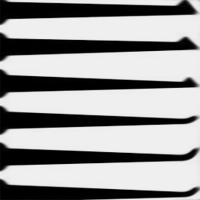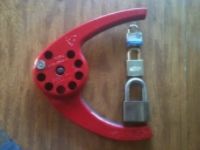|
Information about locks themselves. Questions, tips and lock diagram information should be posted here.
 by jbrint » 8 Oct 2015 6:10 by jbrint » 8 Oct 2015 6:10
So I had been picking this lock for about a week. Last week I was consistently getting opens and then nothing. Got after it again last night and got it open. Problem is now it looks like the pins have rotated to the bottom of the keyway. I am pretty sure the lock is a waste but had 2 questions: 1. Can I get this back open to remove the damaged core? 2. What did I do wrong to get it into this position? Here is the lock and thanks in advance. 
-

jbrint
-
- Posts: 208
- Joined: 7 Aug 2015 22:27
- Location: Houston, Texas
 by femurat » 8 Oct 2015 7:33 by femurat » 8 Oct 2015 7:33
I think you have rotated the plug too much. This is not possible with a key because the drill breaker stops it, but can happen while picking. If you insert a flat piece of steel, like the handle of a tension wrench, in the bottom of the keyway, you can lift all the top pins while turning the plug CCW. This should solve your problem. Good luck 
-

femurat
- Site Admin
-
- Posts: 3757
- Joined: 22 Sep 2008 9:06
- Location: Italy
 by GWiens2001 » 8 Oct 2015 7:35 by GWiens2001 » 8 Oct 2015 7:35
Femurat is refering to lifting the driver pins. They have dropped into the bottom of the keyway, and are blocking rotation.
Gordon
Just when you finally think you have learned it all, that is when you learn that you don't know anything yet.
-

GWiens2001
- Site Admin
-
- Posts: 7587
- Joined: 3 Sep 2012 16:24
- Location: Arizona, United States
 by femurat » 8 Oct 2015 8:12 by femurat » 8 Oct 2015 8:12
Thanks Gordon, being the locks here mounted upside down, I always confuse top and bottom pins. Cheers 
-

femurat
- Site Admin
-
- Posts: 3757
- Joined: 22 Sep 2008 9:06
- Location: Italy
 by jbrint » 8 Oct 2015 8:14 by jbrint » 8 Oct 2015 8:14
I appreciate the insight gents I will have a go at it when I get home this evening and see if I can sort it out. I enjoy this lock so I would love to be able to keep enjoying it. I will be a bit more careful next time so as not to do this again.
-

jbrint
-
- Posts: 208
- Joined: 7 Aug 2015 22:27
- Location: Houston, Texas
 by jbrint » 8 Oct 2015 18:32 by jbrint » 8 Oct 2015 18:32
So after looking at this and trying your recommendation, I realized I did something that looks to be pretty dumb. From the looks of it I rotated the cylinder in the wrong direction instead of back to close. I haven't been able to get the pins back in to rotate it back so I have a feeling this will just have to be chalked up to a rookie learning lesson and this can go in the dissection box for autopsy. Thanks again for the insight.
-

jbrint
-
- Posts: 208
- Joined: 7 Aug 2015 22:27
- Location: Houston, Texas
 by GWiens2001 » 8 Oct 2015 19:14 by GWiens2001 » 8 Oct 2015 19:14
jbrint wrote:So after looking at this and trying your recommendation, I realized I did something that looks to be pretty dumb. From the looks of it I rotated the cylinder in the wrong direction instead of back to close. I haven't been able to get the pins back in to rotate it back so I have a feeling this will just have to be chalked up to a rookie learning lesson and this can go in the dissection box for autopsy. Thanks again for the insight.
It should still work. A number of us will pick the lock backwards. Gordon Just when you finally think you have learned it all, that is when you learn that you don't know anything yet.
-

GWiens2001
- Site Admin
-
- Posts: 7587
- Joined: 3 Sep 2012 16:24
- Location: Arizona, United States
 by jbrint » 8 Oct 2015 20:38 by jbrint » 8 Oct 2015 20:38
GWiens2001 wrote:jbrint wrote:So after looking at this and trying your recommendation, I realized I did something that looks to be pretty dumb. From the looks of it I rotated the cylinder in the wrong direction instead of back to close. I haven't been able to get the pins back in to rotate it back so I have a feeling this will just have to be chalked up to a rookie learning lesson and this can go in the dissection box for autopsy. Thanks again for the insight.
It should still work. A number of us will pick the lock backwards. Gordon
Sounds like I might just have to stay at it then. Thanks again.
-

jbrint
-
- Posts: 208
- Joined: 7 Aug 2015 22:27
- Location: Houston, Texas
 by Evan » 10 Oct 2015 2:36 by Evan » 10 Oct 2015 2:36
GWiens2001 wrote:
It should still work. A number of us will pick the lock backwards.
Gordon
With the cylinder 180 degrees out of phase from where it should be, if this padlock was one of the (NKR) Non Key Retaining actuators the OP now has a brick/paperweight because the cylinder will not turn in the correct direction once the lock was closed... The "play" in American padlock cylinders of the NKR type actuated locks is there because the quarter-round piece on the actuator allows it to snap closed against the half-rounded end of the cylinder. With it 180 degree out-of-time you would need to rotate the actuator the wrong way to free it up... The cylinder and shell of the lock can be saved, but it will require destructive methods to be used to free the cylinder from the body of the lock at this point... ~~ Evan
-
Evan
-
- Posts: 1489
- Joined: 5 Apr 2010 17:09
- Location: Rhode Island
 by jbrint » 10 Oct 2015 7:40 by jbrint » 10 Oct 2015 7:40
Evan wrote:GWiens2001 wrote:
It should still work. A number of us will pick the lock backwards.
Gordon
With the cylinder 180 degrees out of phase from where it should be, if this padlock was one of the (NKR) Non Key Retaining actuators the OP now has a brick/paperweight because the cylinder will not turn in the correct direction once the lock was closed... The "play" in American padlock cylinders of the NKR type actuated locks is there because the quarter-round piece on the actuator allows it to snap closed against the half-rounded end of the cylinder. With it 180 degree out-of-time you would need to rotate the actuator the wrong way to free it up... The cylinder and shell of the lock can be saved, but it will require destructive methods to be used to free the cylinder from the body of the lock at this point... ~~ Evan
I believe this was a key retaining lock. I never had the key to confirm but the behavior I based that on is the shackle wouldn't lock without moving the cylinder to a closed position. I have purchased an "American 1100" tool to see if I can get the shackle open and remove the cylinder.
-

jbrint
-
- Posts: 208
- Joined: 7 Aug 2015 22:27
- Location: Houston, Texas
 by Evan » 10 Oct 2015 13:00 by Evan » 10 Oct 2015 13:00
jbrint wrote:
I believe this was a key retaining lock. I never had the key to confirm but the behavior I based that on is the shackle wouldn't lock without moving the cylinder to a closed position. I have purchased an "American 1100" tool to see if I can get the shackle open and remove the cylinder.
The shape of the actuator would prevent the situation which has happened from happening. The half-round actuator of the key retaining locks completely interlocks with the half-round tailpiece on the back of the cylinder. ~~ Evan
-
Evan
-
- Posts: 1489
- Joined: 5 Apr 2010 17:09
- Location: Rhode Island
 by kwoswalt99- » 10 Oct 2015 13:24 by kwoswalt99- » 10 Oct 2015 13:24
Evan wrote:jbrint wrote:
I believe this was a key retaining lock. I never had the key to confirm but the behavior I based that on is the shackle wouldn't lock without moving the cylinder to a closed position. I have purchased an "American 1100" tool to see if I can get the shackle open and remove the cylinder.
The shape of the actuator would prevent the situation which has happened from happening. The half-round actuator of the key retaining locks completely interlocks with the half-round tailpiece on the back of the cylinder. ~~ Evan
Actually, without a key, it can turn 180. CCW it will only go about 90, but if you push the shackle back in after it's open, it will continue turning CW to 180. To fix your lock, lift all the drivers with something straight, push the shackle in(this is the important part), and turn it back CCW.
-
kwoswalt99-
-
- Posts: 1218
- Joined: 17 Mar 2015 15:35
- Location: Somewhere.
 by kwoswalt99- » 10 Oct 2015 13:28 by kwoswalt99- » 10 Oct 2015 13:28
Also important to note, the keypins will fall into the holes in the bottom of the cylinder, so you will also need to do this with the keyway facing up.
-
kwoswalt99-
-
- Posts: 1218
- Joined: 17 Mar 2015 15:35
- Location: Somewhere.
Return to Locks
Who is online
Users browsing this forum: No registered users and 3 guests
|
